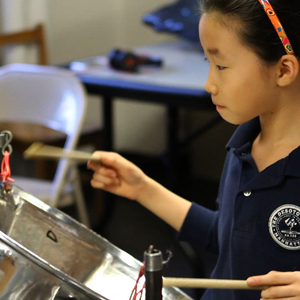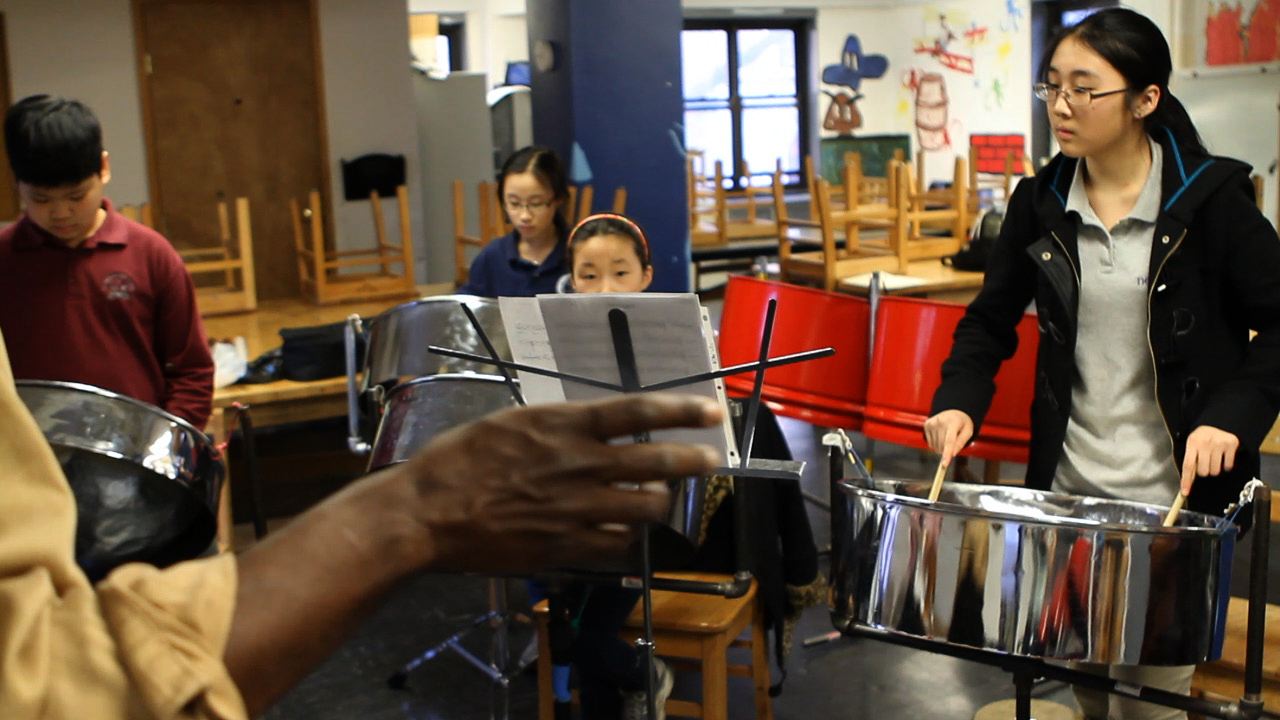 NEW YORK — A shabby community center on the first floor of one of the 12 buildings that make up the vast Gov. Alfred E. Smith public houses is where social workers and teachers are hoping music can break down cultural barriers.
NEW YORK — A shabby community center on the first floor of one of the 12 buildings that make up the vast Gov. Alfred E. Smith public houses is where social workers and teachers are hoping music can break down cultural barriers.
Melodies drift from the classroom in the tiny Two Bridges neighborhood of lower Manhattan, six days a week. It is in need of fresh paint. Mismatched desks are scattered amidst tables and other pieces of furniture. Remnants of English language lessons line the walls on yellowing easel paper. It is here, in a housing project named after a progressive social reforming governor, where children attempt tentative scales, interrupted by an instructor’s praise and encouragement to practice at home.
But the music school — run by Hamilton Madison House a progressive non-profit — which offers piano, violin, guitar and even steel pan lessons for a reduced fee, is a well-kept secret, patronized almost entirely by Asian families, not the black and Latino kids who also live in the housing project.
Thea Goodman wants to change that. Goodman, the house’s Assistant associate director of Cultural Affairs and social worker by trade, said she remains frustrated by the dearth of black and Latino children. She has spent the seven years of the program’s existence trying to bring in different members of the community, even paying for students’ lessons with her own money.
“We just go out there to some of the churches, to some of the schools, just walking out on the street every day just giving out fliers,” Goodman said. “I carry them with me. That’s how you do it.”
The Hamilton-Madison House was established as part of the settlement house movement in 1898. The settlement house movement, started in the 19th Century, was started by middle-class social reformers trying to alleviate the wretched conditions of the poor. Over the years, it has offered various social services, translation for immigrants, legal help, health programs and music lessons. The music program has 135 students with the youngest maestros starting at age four. Students pay about $29 per class for 32 classes, and they receive a free instrument rental.
It’s not unusual that the program has a lot of Chinese participants. Located just blocks from Chinatown, the Alfred E. Smith houses have an unusually high Asian resident population (some 1,800) when it comes to city public housing.
 Still, of the almost 4,300 residents in the Smith houses, almost 800 are black, and about 1,600 are Latino. To attract those residents, the House’s executive director Mark Handelman suggested starting a steel pan class, hoping that the music of Trinidad and Tobago would attract different students than piano and violin. This class is only $20 for the entire year.
Still, of the almost 4,300 residents in the Smith houses, almost 800 are black, and about 1,600 are Latino. To attract those residents, the House’s executive director Mark Handelman suggested starting a steel pan class, hoping that the music of Trinidad and Tobago would attract different students than piano and violin. This class is only $20 for the entire year.
“I don’t think he thought that it would turn out to be an Asian steel band group,” Goodman said, laughing. “I think his thought was that we’d get a bunch of teenagers off the street. But those aren’t the kids that decided to come.”
The children who came, like Fanny Lawren’s three daughters, Salinda, 8; Casandra, 10; and Vernita, 13, were already taking violin lessons at the school, and learning traditional Chinese instruments. They saw the fliers for the steel drum band and thought it looked fun.
“We hadn’t tried other cultures, so we wanted to try a new experience,” said Vernita.
Still, Goodman said, there is something intriguing about a mostly-Asian steel pan band. It’s the only one of its kind in the city, and class teacher Rudy Crichlow says it’s no different than American-born children learning European or African music.
“Music is something that’s exported,” he said. “When you start something like a steel band or whatever cultural expression you have and it’s captured and spread around the world it’s a beautiful thing.”
Goodman recognizes it will be a challenge to bring in new faces. Most hear about it through word-of-mouth.
Jomella Watson-Thompson, a professor with the Department of Behavioral Science, and associate director of Workers for Community Health and Development at the University of Kansas, said if Asian families are the only ones championing the program to other parents and friends, new participants will most likely be Asian too.
What the Hamilton-Madison House music school needs is to find champions among the Latino and black youth, said Watson-Thompson, and sometimes, the champions for these young people won’t be their parents.
“Champions can be churches and faith groups, especially among the African-American community,” she said.
Heather Lewis-Charp, a social scientist at Social Policy Research Associates in Oakland, Calif., said people are hesitant to join programs unless there are other people who “look like them” already involved.
“It’s this sense of belonging that gets people coming, especially if there’s a perceived barrier,” Lewis-Charp said. “There has to be a really strong relational draw either through their friends or through a staff member where they feel comfortable to make the mistakes that come with learning an instrument.”
Another barrier, Lewis-Charp said, is perceived cost, and the music school fliers do not have the program cost listed. Lewis-Charp said that violin and piano are traditionally thought of as “expensive” — potential participants might think they have to purchase or own an instrument.
But this is exactly the opposite image Goodman said she wants to portray. She said there are people who have paid nothing, people who have paid reduced rates, and people who have volunteered in exchange for lessons.
“No one gets turned away because of cost,” she said. “And that’s one of the reasons we’re always having to fundraise.”
However, Goodman said there’s no formal scholarship — the discounts happen on a case-by-case basis at Goodman’s discretion.
If they want to expand diversity, experts said, they need to solicit advice from the black and Latino youth in the community, and not just those who are already participating in the music school.
“There are some types of musical opportunities that appeal to some cultures more than others,” said Watson-Thompson. “For some cultures, soccer is the popular sport; for others it may be basketball.”
Goodman said the school has a lot to offer once students commit. They perform in at least two recitals a year, and some have even performed at Carnegie Hall in an inter-school orchestra. And she said, studies show that music helps children develop lifelong skills, like math and reading.
“It helps develop discipline,” Goodman said. “And also helps them to develop talents that they may have. And if they don’t go on to use it in some more formal way, they’ll be wonderful audience members and really appreciate music for the rest of their lives. And I don’t think that that has a downside.”
Photos by Christine Streich































